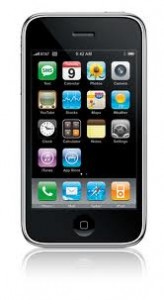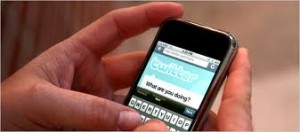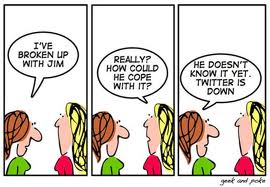7
04
2011
Kevin Anderson, now working for Al Jazeera Arabic in Doha, Qatar, has over a decade of journalism experience under his belt. Along with jobs at The Guardian and BBC News, Anderson has been a digital journalist since 1996 and rode the .com boom to becoming the BBC’s first online journalist outside of the UK.

Anderson’s main points:
- What tools do journalists need to know how to use?
- Internships
- Setting up blogs (knowing how to write, take pictures, edit video)
- The role of social media in journalism today?
The major role is “networked journalism”
- Not enough to build a website, make sure content is available and take it to places were people are congregating online, like Facebook and Twitter.
- Using networks to find sources and add voices to our journalism
- How do we differentiate ourselves as journalist?
If we amplify everyvoice it just becomes noise(when it comes to people trying to be their own reporters) it’s still important to make editorial choices. We just have a richer wider choice of quotes.
Kevin and his wife, Suw Charman-Anderson, have a blog called the Corante. Check out their postings.
Comments : No Comments »
Tags : Al Jazeera, Corante, facebook, Kevin Anderson, Twitter
Categories : Tech Blog Items
22
02
2011
The evolution of cell phones have raised the bar on reporting. Now that phones can capture quality videos, photos and audio files, readers don’t have to wait for first hand coverage. A reporter can rush to the scene and capture everything on his or her mobile device without having to wait for the camera crew to appear.

- Mobile reporting is a whole new field of journalism where the reporter does it all: write, update and transmit photos and videos directly to their audience. Mobile reporters don’t have to work for JUST print, online, radio or TV, they can work in all mediums because they can update from anywhere and whenever they want. Increasingly, news footage is coming form citizens who were on the scene by coincidence and picked up their phone.
*The only technical gadget necessary to be a mobile journalist is a mobile device that connects to the Internet and allows you to publish texts, videos and pictures. You don’t need a hikers backpack full of equipment to haul around from place to place, just an iPhone or a Blackberry.

- Deciding on whether to go “mobile” on a news story can be difficult. Here are some places that Briggs suggest you take the cellular plunge:
- Breaking news, such as fires, shootouts, auto accidents, plane crashes etc.
- Important speeches or announcements by prominent figures
- Sporting events
- Protests/Political rallies/parades
- Criminal and Civil trials
- Mobile microblogging: Microblogging is still being held up by many cell phone holding hands, with Twitter being the dominant Web site. Many journalists use microblogging as a way of taking notes, say during a sports game, Tweets bring up to the minute plays that a reporter can later go back and consult for an article.

Comments : No Comments »
Tags : mobile journalism, mobile reporting, Twitter
Categories : Mark Briggs "Journalism Next"
21
02
2011
News is never reported the day after anymore. You don’t have to patiently wait for the evening news or tomorrows paper to catch up on the latest stories. Briggs explains the phenomenon that has swept the Web: Microblogging.

- A microblogging service allows someone to publish small messages, usually no more than 140 characters, where you can use links to other Web sites, photos or videos. The most famously addictive Web site out of all the many microblogging sites would have to be Twitter. Ashton Kutcher first made this site a hit when he started tweeting a year or two ago. Soon teen girls around the country basically put their heads through the computer screen trying to follow Kutcher’s (or aplusk as he’s known in Twitter nation) daily tweets. The ease of publishing and the ease of consuming a message is the reason for microbloggings rapid growth over the past couple years.

I’d follow his Tweets.
*Another example of microblogging would be Facebook‘s status updates. The “What’s on your mind?” box has probably grown to be the most used feature on Facebook.
- Microblogging is quickly causing an information revolution. We get updates in real-time and, somtimes, we get the news straight from the source itself. Take Egypt for example, just a couple weeks ago the protesters in Tahrir Square tweeted their grievances, thoughts, ideas and protests to the world via Twitter and Facebook. When the government soon caught on and blocked Internet access to the country, Google and Twitter launched a service where Egyptians could call a certain number and leave a voicemail, then resulting in a Tweet that was recognized with “#egpyt.” Read the article here.
*To understand the world of Twitter, you must learn the language.
Tweet: A verb that meaning sending a message on Twitter, as a noun it means the message sent or received.
RT: Retweet, is when you copy someone else’s tweet and posting it so your followers can see it.
tworld: simply Twitter world
tweeples: those who use Twitter
This brings us to hashtags or simply “#.” They are used to mark key words or topics in a Tweet, ultimately creating a trend out of the word. (like the #egypt example used earlier)
Whether you hate it or embrace it, you can’t deny that Twitter and other microblogging sites are taking over the world. Literally. Kim Kardashian is reportedly being paid 10,000 USD to tweet to her followers about a product. If that kind of money doesn’t motivate you to create an account than I don’t know what will.

Comments : No Comments »
Tags : Ashton Kutcher, facebook, microblogging, Twitter
Categories : Mark Briggs "Journalism Next"
17
02
2011
To sum up this chapter, today an aspiring journalist needs to have a blog. You need to be able to keep up with all the media outlets, Twitter, Facebook and all the other web pages that are making news travel at the click of a button. Blogging is the art of keeping up an online conversation. No longer are we forced to go out and make connections first hand, because now we can turn to our cell phones, ipads, or laptops to find out what we want at any time.

- A blog is a simple form of communication, because they’re fast, interactive, and allows you to further illustrate your story with links, videos and pictures. Blogging can help you cover a beat and build a loyal band of followers whose interactions contribute to your coverage.
Briggs “Blog Basics” include three characteristics that define a blog:
1. It is a frequently updated Web site with entries displayed with the most recent posts on top
2. Each entry, a post, has a headline and a body. Entries can contain links to other sites, photos and videos.
3. Most blogs allow the readers to comment on these posts.
The simplicity of the blog is what made it so popular today. You don’t have to spend hours hunched over the computer going cross-eyed staring at the screen trying to figure out how to make a web site by computer code. Nowadays, creating a blog is almost as easy as sending an email.

- Becoming a blogger: READ OTHER BLOGS. Go straight to Google and find blogs about topics that interest you. The blogs you read, the more acquainted you become with the language and the format. Note what you like about the blog and what you would never want to look at again. I go to about five everyday, all of which are either music blogs or food blogs, but still I’m at least getting out into the world of blogging.
- Customize your blog. Now don’t go crazy and put flash animation with sparkling pink fireworks all over the place, and please don’t add a little icon that follows your mouse around the screen. Those are quite frankly annoying. Make it appealing and use basic CSS to customize the style and feel of your blog. For an example, you can do this by uploading your own header image, the picture at the top of your blog. Customize it to reflect something about you or the topic your writing about. Widgets are also something to add personality to your blog. They are small applications that can be added to any Web page, for example a search bar, or an RSS feed.
- Build an audience for your blog. Post early and post often, so people can rely on you to get fresh news daily and at the start of their day. Know what your reader wants, by looking at comments and your most popular posts. A good blogger knows how to keep their readers interested by knowing how to clearly communicate and idea, news or analysis quickly.
If you’re looking for any inspiration, check out TIME magazines best blogs of 2010 here.
Comments : No Comments »
Tags : blog, facebook, Twitter
Categories : Mark Briggs "Journalism Next"







